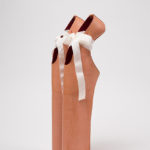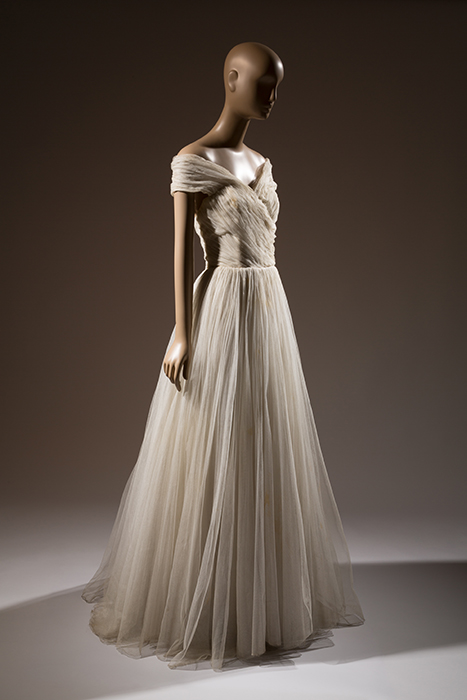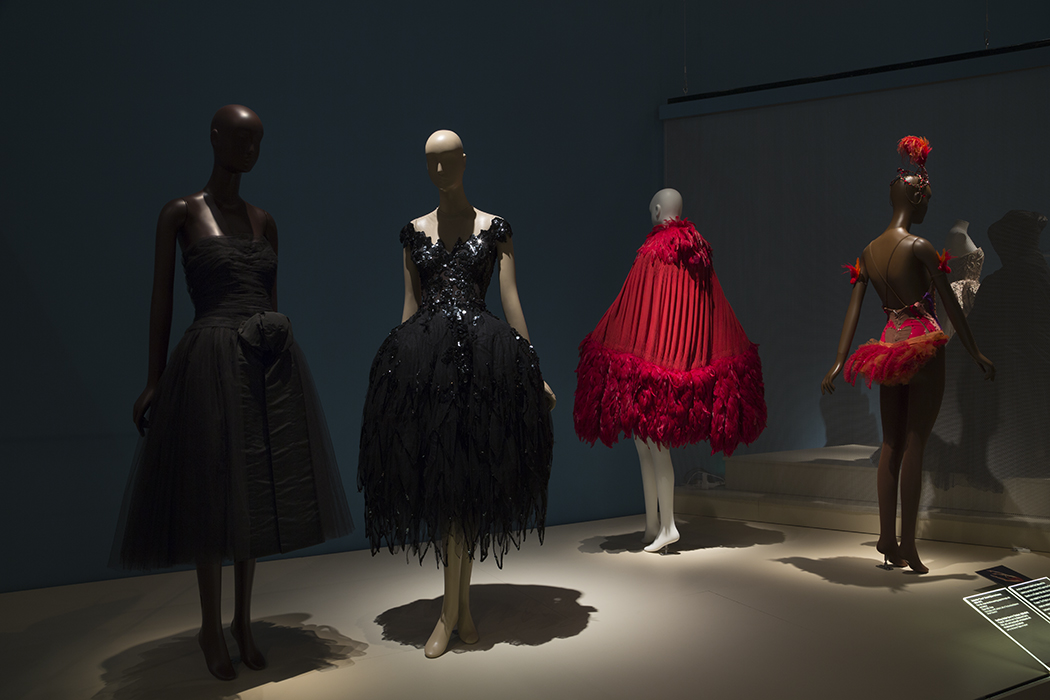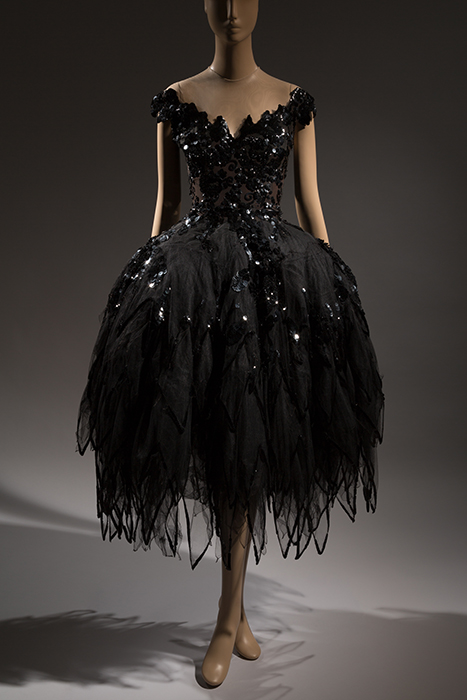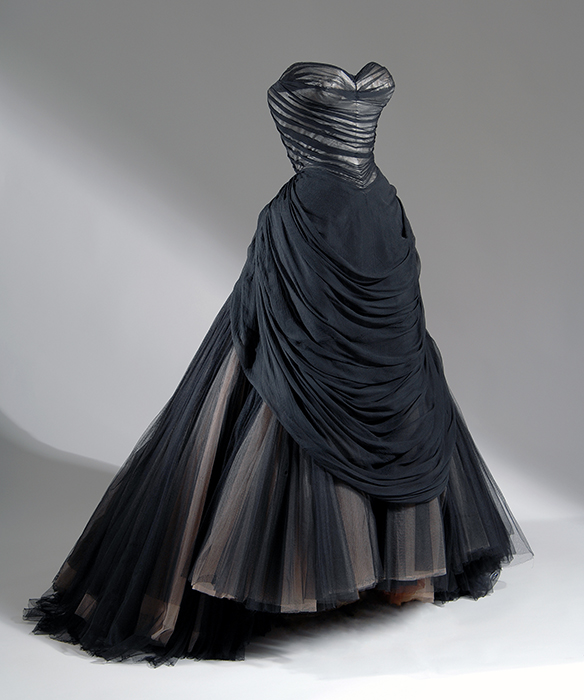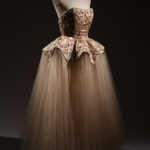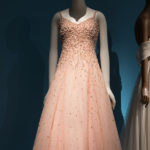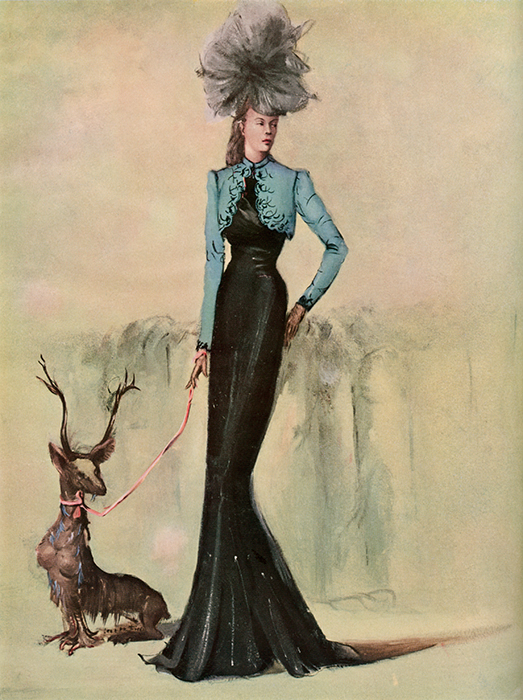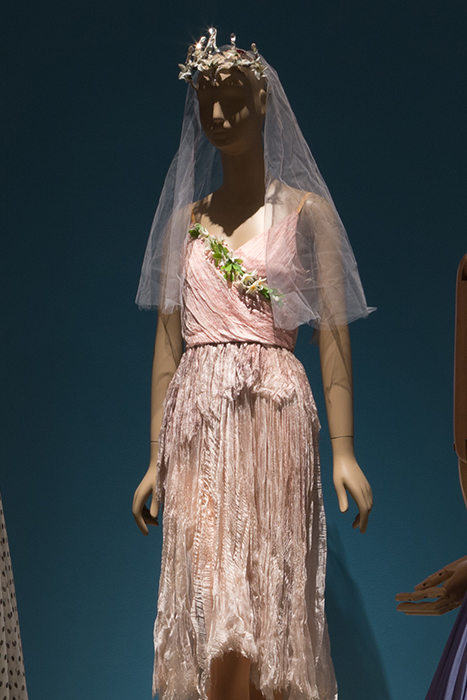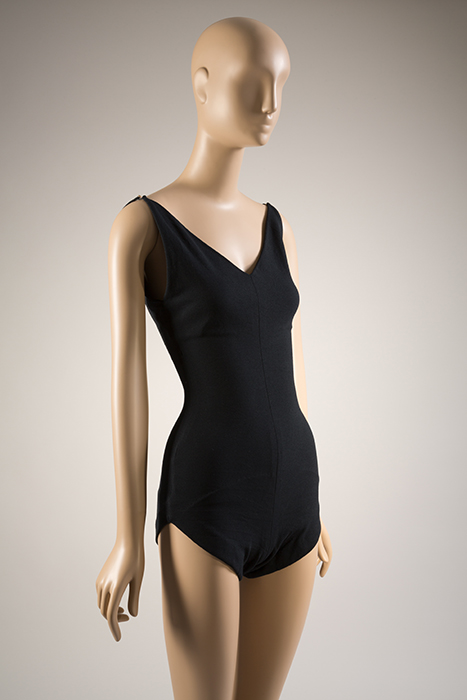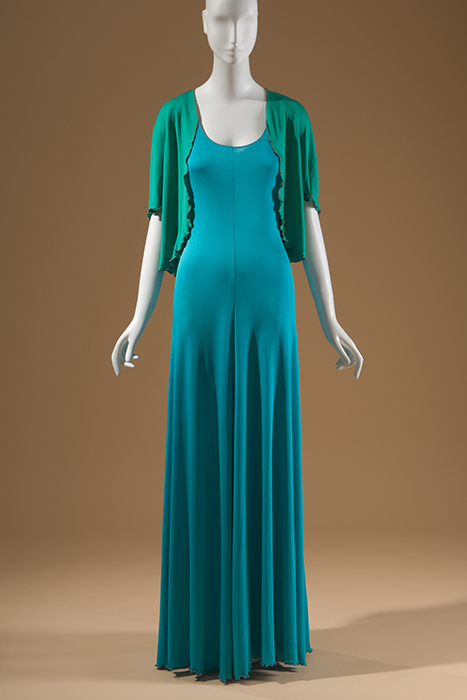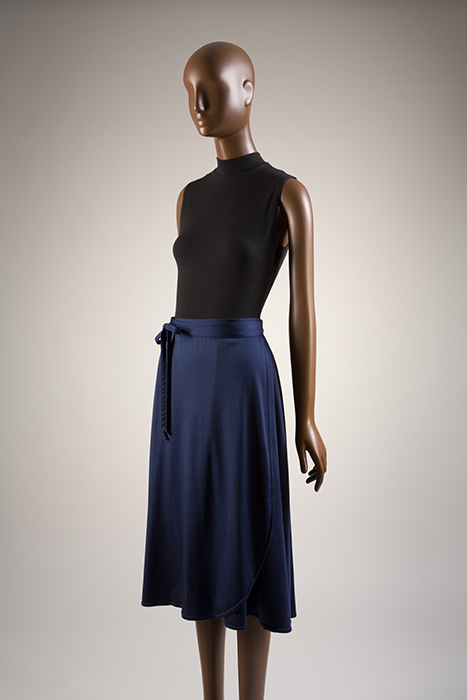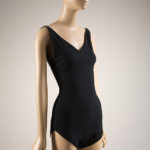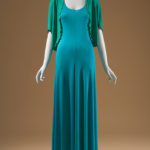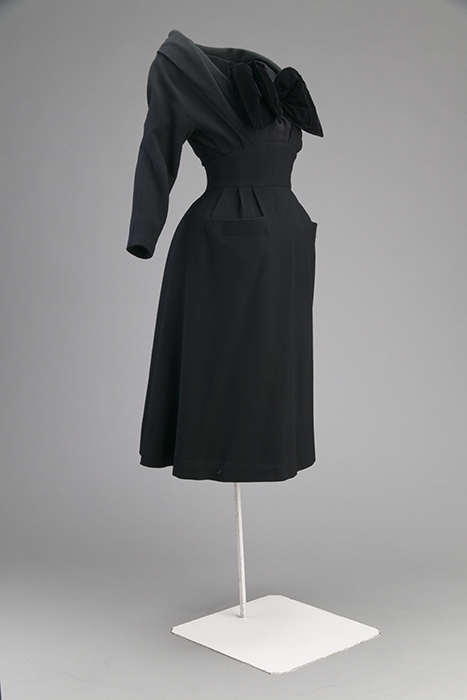Ballet Style Footwear
The flat-heeled “ballerina” slipper is worn by millions today. In 1941, fashion editor Diana Vreeland pioneered the idea of ballet shoes as streetwear because they were exempt from wartime restrictions. While all ballet dancers wear soft slippers, only the ballerina dons the iconic pointe shoe. Its magic inspired a few contemporary designers to create extreme, fetishistic versions.
-
Image InfoClose
“The Ballet Slipper”
“The Ballet Slipper,” Harper’s Bazaar, July 1941. Photograph by Henle
-
Image InfoClose
Claire McCardell ensemble
Claire McCardell was perhaps the first designer to pair her garments with real ballet slippers. In 1942, she chose footwear by the dancewear company Capezio. They later collaborated and the popularity of their joint efforts led to the creation of now ubiquitous, street-worthy “ballerina” shoe.
Claire McCardell for Townley, active wear ensemble with ankle boots by Capezio, 1945-1955. The Museum at FIT, 72.61.60. Gift of Mr. and Mrs. Adrian McCardell. ©The Museum at FIT
-
Image InfoClose
Christian Louboutin pointe shoes
Beautiful and magical on stage, the pointe shoe has become a fashionable fetish object. Christian Louboutin stated that in his Fetish Ballerine, the wearer, like a dancer, is “closer than any other woman to the sky, closer to heaven!”
Christian Louboutin, “Fetish Ballerine” patent leather and grosgrain pointe shoes, 2014. The Museum at FIT, 2014.35.1. Gift of Christian Louboutin. ©The Museum at FIT
-
Image InfoClose
Noritaka Tatehana pointe-style shoes
Noritaka Tatehana’s extreme version of the ballerina’s pointe shoe, was designed for Lady Gaga’s Marry the Night video. Eighteen inches long, its fetishistic appeal was enhanced with Gaga’s latex costume.
Noritaka Tatehana (born in Japan, 1985) pink leather heelless platform ballerina pointe-style shoes, 2012. The Museum at FIT, 2012.39.1 ©The Museum at FIT
The Neo-Romantic Revival
During the 1930s, fashionable evening clothes began to resemble the classical ballerina’s tutu for the first time, especially the longer, calf-length version first created in the 1830s. Couturiers designed Les Sylphides and Giselle-style gowns, with fitted and lavishly embroidered bodices that sat atop evening skirts made from filmy fabrics such as tulle, or silk netting.
-
Image InfoClose
Installation View
-
Image InfoClose
Pierre Balmain evening dress
Pierre Balmain, off-white tulle evening dress, circa 1955. The Museum at FIT, 76.42.24. Gift of Mrs. John Thomas Trippe. ©The Museum at FIT
-
Image InfoClose
Norman Hartnell gown
The British lead the western ballet craze while passionately embracing the neo-romantic revival. Ballets such as Frederick Ashton’s Apparitions, with costumes by Cecil Beaton, had a direct impact on couturiers such as Norman Hartnell, who produced an array of frothy, ballerina-inspired gowns for actresses, socialites, and even Queen Elizabeth, the Queen Mother.
Norman Hartnell, beige silk tulle gown embroidered with metal sequins, circa 1939. Collection of Beverley Birks. ©The Museum at FIT
-
Image InfoClose
Chanel evening dress
The romantic style tutus in George Balanchine’s 1932 ballet Cotillon were designed by the artist Christian Bérard. His star-covered, tulle costumes inspired couturiers such as Coco Chanel. Although an avowed modernist, Chanel’s dark blue tulle gown is one of many she created during the 1930s that took its cue from the ballerina’s stage costume.
Chanel, American licensed copy of “Etoiles” navy blue tulle evening dress, 1937. The Collection of Beverley Birks. ©The Museum at FIT
Ballerina as Bird
Numerous ballets include characters and choreography inspired by birds but no avian species has been as closely connected to ballet as the sinuous, long-necked swan. One reason was the popularity of Anna Pavlova’s Dying Swan solo. Another was the impact of Swan Lake, one of the greatest ballets of all time.
-
Image InfoClose
Installation View
-
Image InfoClose
Pierre Balmain evening dress
The role of Odette, also known as the White Swan, is one of the most famous and coveted ballerina roles in the classical ballet canon. From the 1930s to the 1960s, Odette’s white feathered costume inspired an array of couturiers including Robert Piguet, Pierre Cardin, and Pierre Balmain.
Pierre Balmain, pink satin and white coq feather-trimmed tulle evening dress, circa 1950. The Museum at FIT, 91.244.1. Gift of Barbara Louis. ©The Museum at FIT
-
Image InfoClose
Photograph of Anna Pavlova as the Dying Swan
Photograph of Anna Pavlova as the Dying Swan, 1905. Photograph by Herman Mishkin. Jerome Robbins Dance Division, The New York Public Library for the Performing Arts, Astor, Lenox and Tilden Foundations
-
Image InfoClose
Howard Greer evening dress
The character of Odile in Swan Lake, the second of two roles danced by a single ballerina and frequently referred to as the “Black Swan,” also inspired designers. After World War II, the name “Black Swan” became so popular that couturiers named their creations “Odile” as well as “Le Cygne Noir” (or “Black Swan,” in French).
Howard Greer, “Odile” black silk tulle evening dress embroidered with sequins, circa 1951. Collection of Beverley Birks. ©The Museum at FIT
-
Image InfoClose
Chanel evening cape
Ballerinas who dance the vibrant and magical role of the Firebird don a brilliantly feathered costume. The exhibition features a contemporary version created for the Dance Theatre of Harlem that retains the color and spirt of the 1910 original. Coco Chanel’s 1920s red feathered cape echoes the Firebird costume, illustrating fashion’s growing influence on ballet during the interwar years.
Chanel, red silk crepe de chine and feather evening cape, 1927. The Museum at FIT, 96.69.15. Gift from The Dorothea Stephens Wiman Collection. ©The Museum at FIT
From Costumier to Couturier
Ukranian émigré Barbara Karinska was arguably the greatest ballet costumier of the mid-century. She first made her mark collaborating with European artist/designers such as Christian Bérard and Cecil Beaton in the 1930s. At the onset of World War II, she moved to America, where she went on to form a legendary collaboration with fellow émigré, choreographer George Balanchine.
-
Image InfoClose
Barbara Karinska (original), Marc Happel (recreation) costume
Barbara Karinska (original), Marc Happel (recreation), La Valse costume based on the 1951 original for the New York City Ballet. Lent by Marc Happel, Director of Costumes, New York City Ballet. ©The Museum at FIT
-
Image InfoClose
Charles James “Swan” evening dress
Before embarking on a full-time costume career at the New York City Ballet, Barbara Karinska worked briefly as a couturier. Her innovations, such as long tutus made with different colored layers of tulle, may have influenced couturiers such as Charles James.
Charles James, silk chiffon and satin “Swan” evening dress, 1954-1955. The Museum at FIT, 91.241.136. Gift of Robert Wells In Memory of Lisa Kirk. ©The Museum at FIT
New York City Ballet and Fashion Today
Marc Happel is director the New York City Ballet’s costume shop. Best known for collaborating with leading fashion designers who create costumes for newly commissioned ballets featured at NYCB’s annual fall fashion gala, Happel is also a creator in his own right. Important examples include the redesign of the company’s signature work, Symphony in C.
-
Image InfoClose
Installation View
-
Image InfoClose
Marc Happel costume
Marc Happel, costume for George Balanchine’s Symphony in C for the New York City Ballet, 2012. Lent by Marc Happel, Director of Costumes, New York City Ballet. ©The Museum at FIT
-
Image InfoClose
Balenciaga licensed copy by Hattie Carnegie
Marc Happel’s unique knowledge of fashion history can be seen in the scalloped peplum of the Symphony in C. It echoes that of the Cristobal Balenciaga gown which, in turn, was inspired by the Royal Ballet’s 1946 The Sleeping Beauty costume designed by Oliver Messel and worn by Dame Margot Fonteyn.
Balenciaga, licensed copy by Hattie Carnegie of pale pink tulle and embroidered satin gown, 1950. Collection of Beverley Birks. ©The Museum at FIT
-
Image InfoClose
“Princess Aurora” costume
Oliver Messel (born in England, 1904-1978)
“Princess Aurora” costume worn by Margot Fonteyn in Sleeping Beauty.Synthetic chiffons and georgettes, silver and gold braid, sequins, 1960s, England. Victoria and Albert Museum, London, Purchased with the assistance of the London Archives of the Dance.
-
Image InfoClose
MARC HAPPEL Wedding Dress
Sara Mearns is one of the most celebrated ballerinas dancing today. A principal with the New York City Ballet since 2008, she rose to prominence in 2006 after performing the lead role in Swan Lake while still a teenager and a member of the corps de ballet. Although Mearns also dances in musicals, her wedding dress on view reflects her balletic roots. Custom designed by NYCB’s costume director Marc Happel, the dress’s fitted bodice, bell-shaped skirt, and pale tulle fabrication evoke the romantic era tutu.
Marc Happel, embroidered pink tulle wedding dress designed for Sara Mearns, 2018. Lent by Sara Mearns
Ballet Colors and Materials
Perhaps no color is as closely associated with ballet as pink, a hue that was readily incorporated into modern fashion. But pink also illustrated the lack of racial diversity in ballet. For a short time in the 1970s, Capezio pioneered the creation of brown shoes. Freed, a designer of dance shoes, recently revived the production of pointe shoes in a selection of human skin tones.
-
Image InfoClose
Installation View
-
Image InfoClose
Lenore Fini illustration
Arguably the greatest ballet in history is The Sleeping Beauty. Both full-length and one-act versions of this 1890 classic was performed throughout Europe during the interwar years. The vibrant blue costumes worn by the Bluebird and Princess Florine inspired fashion designer Elsa Schiaparelli to create “Sleeping” blue couture garments. She also named her Princess-inspired perfume Sleeping.
Lenore Fini, illustration of “Sleeping Blue” evening jacket by Elsa Schiaparelli, Harper’s Bazaar, March 15, 1940.
-
Image InfoClose
Lilac Ensembles
The second color closely associated with The Sleeping Beauty is lilac, the signature hue of the story’s savior, the Lilac Fairy. In ancient time, lilac flowers were harbingers of spring while purple was a color reserved for royalty. During the Victorian era, pale purple became the color of half mourning. Strict mourning rituals fell out of favor by the early twentieth century, and fashion embraces the new-found youthful spirit of lilac. After Sergei Diaghilev’s 1921 restaging of the Russian classic, lilac’s connection to mourning was all but erased as designers created dresses in a range of purple hues throughout the midcentury.
Nettie Rosenstein (Left) lilac and purple silk chiffon and velvet evening dress, circa 1950. The Museum at FIT, Gift of Doris Duke
Gilbert Adrian (Right) lilac and purple silk gauze, taffeta, and tulle evening dress, circa 1947. The Museum at FIT, Gift of Robert Renfield
-
Image InfoClose
Alix Grès Ensembles
During the 1960s, Mimi Paul was one of America’s finest ballerinas. A principal dancer with both the New York City Ballet and the American Ballet Theatre, she was the American incarnation of the British “dolly bird” who appeared frequently in fashion magazines. With her long, slender physique and large, doe-like eyes, Paul wore costumes and couture with equal aplomb.
Alix Grès
(Left) Pink silk chiffon and crepe evening dress, circa 1967. The Museum at FIT, Gift of Mrs. William Randolph Hearst, Jr.
(RIGHT) White and black polka dotted silk chiffon evening dress, 1967. The Museum at FIT, Gift of Mrs. Michael Batterberry -
Image InfoClose
Mimi Paul Portrait
An image of Paul modeling a polka-dotted chiffon evening dress by the Parisian couturière Madame Grès (identical to the one on view), illustrated her dancerly spirit as well as the kinetic nature of Grès’s work.
Mimi Paul, full-length portrait, standing before sculpture at the New York State Theatre, 1967. New York World-Telegram and the Sun Newspaper Photograph Collection, Library of Congress, Prints and Photographs Division, LC-USZ62-120876 (b&w film copy neg.)
-
Image InfoClose
Carl Michel “Wilis” costume
In 1984, the Dance Theatre of Harlem restaged its version of the romantic classic Giselle. DTH, the brainchild of Arthur Mitchell, the pioneering African American principal dancer with the New York City Ballet, was founded in 1969 in order to provide dancers of color professional opportunities that racism had long denied them. Mitchell’s restaging of the romantic-era classic, renamed Creole Giselle, was a hit. Relocated from the Rhineland to the Bayou, the production’s original, frothy tulle tutus were reimagined as degraded chiffon frocks, created just as the “deconstruction” aesthetic entered the fashion realm.
Carl Michel, “Wilis” costume from “Creole” Giselle, 1984. Lent by the Dance Theatre of Harlem
-
Image InfoClose
Tina Leser Evening Gown
Tina Leser, pink rayon evening dress, circa 1950. Lent by Beverley Birks. ©The Museum at FIT
Leotards and Tights as Fashion
Since the 1940s, choreographer George Balanchine’s modern ballets were often performed in just leotards and tights. These costumes inspired the creation of swimwear, leggings, and wrap dresses by designers such as Claire McCardell whose sportswear separates took their cues from both ballet and modern dance. Americans continued to produce leotards and leggings for in the coming decades.
-
Image InfoClose
Installation View
-
Image InfoClose
Vera Maxwell Ensembles
Vera Maxwell was a leading, mid-century American sportswear designer. Prior to her entry into fashion, she was a member of the Metropolitan Opera Ballet between 1919 and 1924. She also worked as a model and began sketching for clothing manufacturers before opening her eponymous firm in 1947. Like her fellow female designers, Maxwell’s output was inspired by sports and the modern American lifestyle. Her work also reflected ballerinas’ practice clothing. Leotards, leggings, and wrapped tops were the inspiration for outfits such as the gray knitted ensemble and the evening dress with a jersey top and full, floor- length skirt seen here.
Vera Maxwell
(Left) Grey and black wool knit top and pants set, circa 1959. The Museum at FIT, Gift of Vera Maxwell
(RIGHT) Black wool jersey and brown satin “Speed Suit” dress, 1975. The Museum at FIT, Gift of Vera Maxwell -
Image InfoClose
Claire McCardell bathing suit
Claire McCardell, nylon knitted bathing suit, 1948. The Museum at FIT, 72.61.54. Gift of Mr. and Mrs. Adrian McCardell. ©The Museum at FIT
-
Image InfoClose
Stephen Burrows dress
During the 1970s in New York, fashion and dance thrived. One reason for this creative boom was increased diversity. Black ballerinas garnered rave reviews and African American models graced fashion runways and magazines. Meanwhile, designers Stephen Burrows and Scott Barrie were turning out jersey dresses and separates that took their cues from ballerinas and disco queens alike.
Stephen Burrows, jersey knit dress and jacket, circa 1979, The Museum at FIT, 2000.110.1, Gift of Nonnie Moore. ©The Museum at FIT
-
Image InfoClose
Bonnie August for Danskin ensemble
The creator who exemplified the intersection between fashion and dancewear was Bonnie August, design director of Danskin, Inc. Her appropriation of the ballerina’s class and rehearsal wardrobe matched the company’s catchy slogan—“Danskin, not just for dancing”—and perfectly described garments that moved seamlessly from the ballet studio to the disco to the street.
Bonnie August for Danskin, mock turtleneck cat suit and wrap skirt, circa 1985 and 1975, The Museum at FIT 2003.61.10 and 2003.61.2, Gift of Bonnie August. ©The Museum at FIT
Ballerina as Woman of Style
The central platform of the exhibition features fashionable clothing worn by celebrated ballerinas of the twentieth century. Couture worn by ballerinas Alicia Markova and Alexandra Danilova stand alongside of contemporary gowns worn by Carole Divet, Debra Austin and Virginia Johnson. Also included is a wedding dress specially designed by NYCB’s Director of Costumes Marc Happel for principal ballerina Sara Mearns.
-
Image InfoClose
Christian Dior evening dress
Christian Dior, silk faille “Tambourin” evening dress worn by Alicia Markova, autumn/winter 1955. Fashion Museum Bath collection. Photograph by William Palmer
-
Image InfoClose
Christian Dior dress
Maria Tallchief was the most famous of the “Five Moons,” or American Indian ballerinas, who danced for leading national and international companies. Of Osage descent, Maria Tallchief was prima ballerina of the New York City Ballet and the first American to dance with The Paris Opera Ballet. She was also a couture client who wore designs by Christian Dior.
Christian Dior, black wool crepe and silk velvet dress worn by Maria Tallchief, 1947. Chicago History Museum, ICHi-063245
-
Image InfoClose
Christian Dior evening gown
No mid-century ballerina exemplified the idea of the ballerina as a woman of style more than Margot Fonteyn. Although she was a stellar example of the restrained British style of dancing, Fonteyn loved Parisian haute couture and massed an enviable wardrobe by Dior and Yves Saint Laurent. Nearly one dozen of her garments examples on loan from the Fashion Museum in Bath, England.
Christian Dior, tulle “Debussy” evening gown embroidered with sequins worn by Margot Fonteyn, spring/summer 1950. Fashion Museum Bath collection. Photograph by William Palmer


















